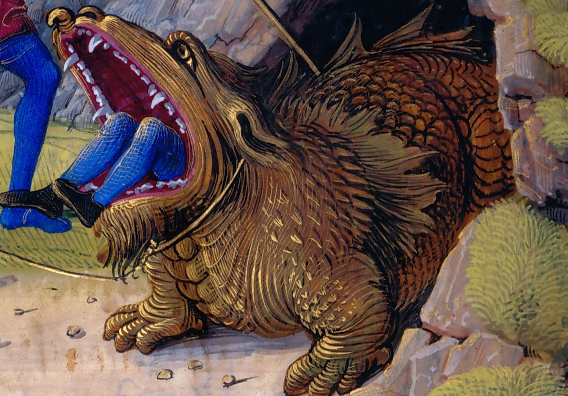 |
| "Hey, little buddy. I won't hurt you. Just gonna sprinkle you and then these French men will bludgeon you. But when the French bludgeon, it's usually with a glove and across the face. So I dunno." |
Today's saint is St. Martha (sister of Mary and Lazarus). She is known traditionally as the patroness of hospitality and cooks (Lk10:38-42). But in true Catholic tradition, we can't just let that be the end-all-be-all of this special lady's story. No. Not only is she a friend of Jesus, a witness to the raising of Lazarus from the dead and a faithful believer in Christ's divinity but she's also known in Gallic circles for something else. Something very cool.
In the 13th Century, a bold and fanciful book of saintly legends called the "Lives of the Saints" or"The Golden Legend" became popularized. In the book, many medieval legends of the saints were told and some of those stories are around today. For a complete day waster, you can see most of the book online and choose as many esoteric, spooky, cool saint stories as your heart's desire. Martha's story takes place in France. Right. She left her little home in Bethany and went to France. Just go with it.
Here's the legend:
There was that time upon the river of Rhone, in a certain wood between Arles and Avignon, a great dragon, half beast and half fish, greater than an ox, longer than an horse, having teeth sharp as a sword, and horned on either side, head like a lion, tail like a serpent, and defended him with two wings on either side, and could not be beaten with cast of stones ne with other armour, and was as strong as twelve lions or bears;(Oh come on...12 lions OR bears? There's like a total difference between the two..which is it?) which dragon lay hiding and lurking in the river, and perished them that passed by and drowned ships.
 |
| A NOM NOM NOM NOM! |
He came thither by sea from Galicia, and was engendered of Leviathan, which is a serpent of the water and is much wood, and of a beast called Bonacho, that is engendered in Galicia. And when he is pursued he casts out of his belly behind, his ordure, the space of an acre of land on them that follow him, and it is bright as glass, and what it toucheth it burneth as fire. To whom Martha, at the prayer of the people, came into the wood, and found him eating a man. (Ha..busted)
And she cast on him holy water, and showed to him the cross, which anon was overcome, and standing still as a sheep, she bound him with her own girdle, and then was slain with spears and glaives of the people. (Dang...heckuva conversion story doncha think?)
The dragon was called of them that dwelled in the country Tarasconus, whereof, in remembrance of him that place is called Tarasconus, which tofore was called Nerluc, and the Black Lake, because there be woods shadowous and black.(Why can't we have good words like 'shadowous' anymore?)
And there the blessed Martha, by licence of Maximin her master, and of her sister, dwelled and abode in the same place after, and daily occupied in prayers and in fastings, and thereafter assembled and were gathered together a great convent of sisters, and builded a fair church at the honour of the blessed Mary virgin, where she led a hard and a sharp life. She eschewed flesh and all fat meat, eggs, cheese and wine; she ate but once a day. An hundred times a day and an hundred times a night she kneeled down and bowed her knees.(Guess that put a cramp in the whole 'baking' and 'mopping' thing.)
The dragon became known as the Tarrasque and has been featured in parades, novels and (nerd alert) DnD style gaming. For those who care, Martha's use of holy water deals 2d4 points of damage to an undead creature or an evil outsider. Each such creature within 5 feet of the point where the flask hits takes 1 point of damage from the splash.
Just saying.


